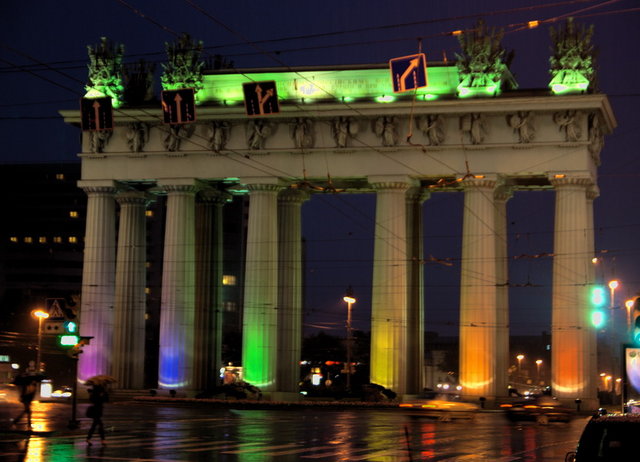|
The cast-iron Moscow Triumphal Arch,
a green monument modeled on Berlin’s
Brandenburg Gate, was built by Stasov in late 1830s to commemorate a whole
series of victories against the Persians, Turks and Poles during the first
decade of Nicholas I’s reign. Stasov, an exponent of the Empire style,
originally developed two different designs for the arch before a full size
model of one of the designs was erected. The project was confirmed on September
14, 1834. In the following year, the Neoclassical sculptor Boris Orlovsky
developed models of the sculpture details of the gate, including war trophies
and figures of geniuses. The chief material to be used in building the gate was
cast iron. The castings for the ends of the columns and walls located above the
cornices, the forging from the sheets of copper sculpture details including the
figures of geniuses, trophies and upper parts of the columns were produced at a
local factory. Each column is composed of nine separate blocks together with
the trunks and the upper units of the columns. All 12 columns weigh
approximately a combined 450 tons. The first column was erected on July 14,
1836. The arch was finally opened two years later, on October 16, 1838. At that
time, the Moscow Arch was the largest structure in the world made of cast iron.
In 1936, during the period of Joseph
Stalin's concentration of power over the Leningrad
leadership, the historic arch was dismantled with plans to move them to Moscow Square
Park. Later, during the
Siege of Leningrad in 1941, when the German army approached the outskirts of Leningrad, the cast iron
blocks of the arch were used in creating an anti-tank defensive structure near
the southern border of the city, helping to repel the Germans during the siege.
The arch was restored from 1958 to 1960. A group of restorers led by the
architect Ivan Kaptsyug managed to recreate most of the lost sculptural details
of the monument. The new columns, friezes and cornices were cast at the Kirov factory in Leningrad.
|




